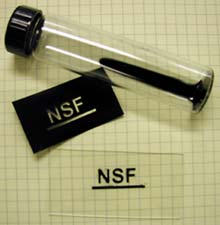Materials Sciences
Materials management deals with the research, development, manufacturing and processing of raw and industrial materials. Key aspects here are biological and medical issues, which play an increasingly important role in this field.
innovations-report offers in-depth articles related to the development and application of materials and the structure and properties of new materials.

Wet scans
The “scanning electron microscope” (SEM) has been a basic research tool for fifty years, and for those fifty years, scientists have been looking for better ways to observe biological samples under its beam. The problem is that the viewing chamber of the SEM must contain a vacuum (in which liquid water in tissues “boils” away). To overcome this difficulty, scientists have had to resort to all sorts of complicated procedures, including coating the specimens with an ultra-fine layer of gold, quick-freez

New Molecule Heralds Breakthrough in Electronic Plastics
New material could mean easier manufacture of paper-thin TVs and “smart” cloth
Researchers have developed a new plastic that conducts electricity, may be simpler to manufacture than industry counterparts and easily accommodates chemical attachments to create new materials.
Developed by TDA Research in Wheat Ridge, Colo., Oligotron polymers are made of tiny bits of material that possess a conducting center and two, non-conducting end pieces. The end pieces allow the plasti

Ancient Greeks help scientists build environmentally friendly nano devices
Institute of Physics Condensed Matter and Materials Physics Conference (CMMP 2004), University of Warwick 4-7th April
A new generation of materials inspired by the ancient Greeks have been developed by scientists for use in miniaturised devices. The materials are robust, flexible films with perforations on the nano scale and have nano coatings. They are environmentally safe and will enable ultra-fast optoelectronic communication. They are produced by the self-assembly of an intricate

Wrapped in polymers
Food packs, containers, toothpaste tubes, wheels, glue, paints … they are all made of polymers. The world of polymers is infinite and, so, there is a great variety. The majority have been designed for a specific application; given that at times the application might be for a food container and, at others, for the superstructure of a vehicle. The specifications needed in either case are quite different.
Polymers are gigantic molecules, but they are synthesised from small compounds: monomer

Stretching the imagination: scientists create “liquid crystal elastomers” with amazing properties
We’ve all sat there in a dull moment at work stretching an elastic band between our fingers and watching it return to its original shape and size as we let it go. But how many of us would have thought of combining the elasticity of rubber with the optical properties of the liquid crystals commonly used in watches, laptops and calculators? On Monday 5th April at the Institute of Physics Condensed Matter and Materials Physics Conference in Warwick, Professor Mark Warner from the University of Camb

Aerogels: ’Solid Smoke’ May Have Many Uses
It looks like glass and feels like solidified smoke, but the most interesting features of the new silica aerogels made by UC Davis and Lawrence Livermore National Laboratory researchers are too small to see or feel. Lighter than styrofoam, this strange material is riddled with pores just nanometers in size, leaving it 98 percent empty.
Water can soak into the material, but in the confined space the water molecules arrange themselves in unusual ways, said Subhash Risbud, professor of chemica